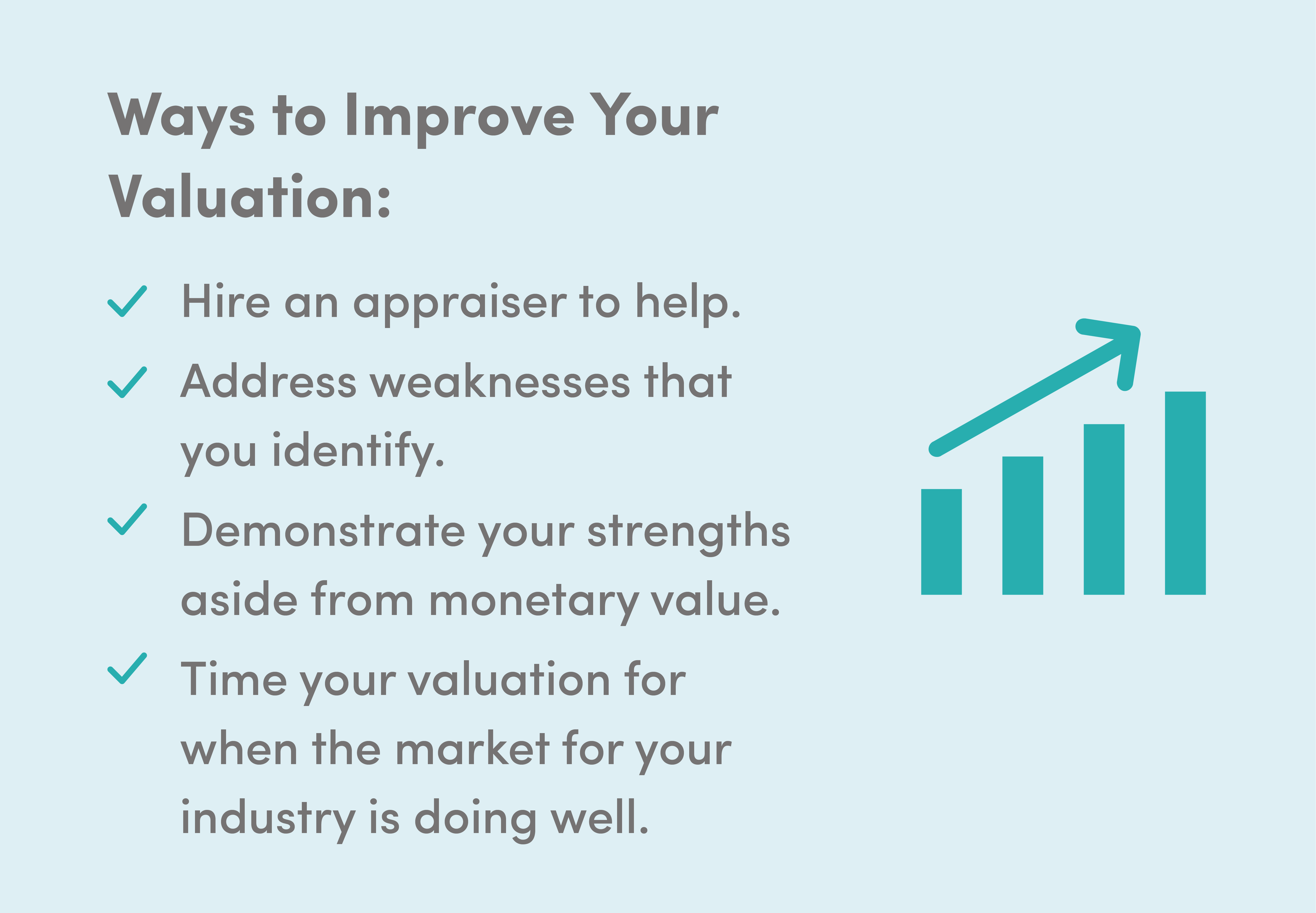Written by: Jacob Dayan
There are a plethora of methods for ascertaining the value of a small business. Most of these methods make use of a small business’s balance sheet, earnings, projections, and recent sales of comparable businesses —called comp sales. Each method has its strengths and weaknesses—and each is optimized for different circumstances. Here is a brief overview of the five most popular small business valuation methods:
A strong balance sheet can facilitate Asset-based valuation. This is because asset-based valuation largely mirrors what is shown on a business’s balance sheet. To use this method, start by totaling the value of your business’s assets before subtracting its liabilities. This should give you the starting value.
To get a more realistic valuation, you may have to weigh the numbers differently. The adjusted net asset method requires knowledge of the business, your industry, and current markets to change the value of the assets and liabilities. For example, you may have accounts receivable that are assets on your books, but you know you won’t likely collect the total amount. If this is the case, you may want to adjust your assets down to reflect their likely real-world values.
The adjusted net asset method is at its best when used to value a business that doesn’t have an abundance of earnings—or is even losing money. It is a commonly-used valuation method for holding companies that own parts of other companies or real estate investments. It is also helpful if you’re considering selling your business—this valuation method is quite useful when used to set a reasonable baseline price.
The capitalization of cash flow (CCF) method has the virtue of being simple; after all, it is the simpler of the two primary income-based methods that business owners use when valuing income-generating businesses.
To calculate the business’s value using the capitalization of cash flow method, divide the cash flow from a specific period by a certain capitalization rate. You will want to use one period’s worth of sustainable and recurring cash flow—you may need to make adjustments for recent one-off expenses or revenue outliers that you don’t wish to include in the results for the sake of clarity.
The capitalization rate—also known as cap rate—refers to a business’s expected rate of return. This is the rate of return a potential buyer could expect to earn if they purchase the company. For small businesses, this figure often hovers around 20% to 25%.
The simplicity of the CCF method makes it less conducive to making business predictions or speculations. However, the CCF method can be a practical valuation method for those valuing a more mature business that is relatively unlikely to experience large or inconsistent swings in cash flow.

The discounted cash flow (DCF) method refers to yet another income-based method. The DCF method utilizes a business’s projected future cash flow alongside the time value of money to calculate the business’s current value. While the CCF is most optimized for enterprises that already boast steady cash flows, the DCF is optimized for companies with more unpredictable futures that may grow or shrink significantly in the coming years.
The time value of money refers to the notion that money is worth more today than it will be in the future. This may seem confusing at first, so let’s look at an example: if you have ten thousand today, you can invest the money, earn interest, and have more than ten thousand dollars in five years. The discounted cash flow model accounts for this, so it can also be helpful for comparing different investment opportunities.
While calculations can tend to be complicated, you can find online valuation calculators—but you will still need to know which numbers to plug in.
A company’s cash flow statement is an ideal jumping-off point, alongside projected cash flows—if they’ve already been created, of course. In addition, you must know the discount rate—otherwise known as the weighted average cost of capital (WACC)—which may require even more complicated calculations. The WACC is the rate the company needs to pay to finance its working capital alongside its long-term debts. Additionally, you must decide how many years’ worth of cash flows you want to include in your valuation.
Market-based valuation relies less on specific business characteristics than current market conditions. When using the market-based valuation method, the company’s current value is determined by comparing the recent sale prices of similar businesses.
Finding comparable business sale prices may be challenging if you are valuing a smaller business. However, you will still want to look for at least a few similar sales if you plan on buying or selling a business. If you need help, you can hire an appraiser; they may also have exclusive access to large databases of business sale figures.
Even if the comparable sales aren’t located in the region your business is in, an appraiser may be able to identify similarly-sized firms within the same or similar industry before making adjustments to reflect your area. It is possible to utilize these results alongside other valuation methods to better value a business.
The previously mentioned valuation methods are great methods to use for businesses of all sizes. However, the seller’s discretionary earnings (SDE) method is utilized for small business valuation exclusively.
The SDE method might be optimal if you’re planning on selling or buying a small business. This is because it helps the buyer ascertain how much income they can expect to earn each year from the company. To calculate the SDE, you will first need to determine the operating costs of the business.
It is best to start with the business’s earnings before interest and taxes—referred to as the acronym EBIT—which you can find on its financial statements. Subsequently, add the owner’s compensation and benefits. Also, total non-essential, non-recurring, and non-related business expenses, including travel, one-off consultancy fees, and more.
Because the SDE is most often used at the time of a small business sale, it’s typical for debates about some of the numbers to ensue — especially regarding the expenses that get added back to determine the value.
Let’s take an example: the seller of a small business might want to classify a marketing project as a one-time expense and subsequently plug that portion back into the earnings in order to increase the valuation. However, the buyer might consider this to be an ongoing project that needs to be revisited and funded annually. For the sale to move forward, they must come to an accord.
There are a plethora of reasons to value your small business. Here’s just a few:

If you’re conducting an informal business valuation, you could do this entirely internally. However, suppose you value your company for a sale or another more serious matter. In that case, it is definitely worth hiring a professional appraiser or business valuation expert such as a bank, lender, or accountant. Whether informal or serious, always take these steps to prepare for a valuation:
Any valuation will be based on managing your small business finances. Even the market-based valuation method synthesizes your business’s financial information to find suitable comparable sales.
You can start by preparing the previous three to five years’ worth of business tax returns, balance sheets, income statements, and cash flow statements. Give each of these statements a thorough look in order to confirm their accuracy.
If you are undertaking a market-based valuation or a DCF, prepare finance-related documents, such as sales reports and industry forecasts.
It depends on the cause for the valuation, but you might want copies of your business licenses, permits, deeds, and certifications available. In addition, prepare documentation for any ongoing contracts with insurers, creditors, vendors, and clients, if applicable.
If you are looking for loans—or selling your business—you will need to share these. You should also prepare your business credit score and reports.
Your balance sheet should list your tangible assets—cash, property, and equipment. Some intangible assets, such as patents or copyrights, may be listed alongside your tangible assets. However, you must consider your other intangible assets that may contribute to your company’s value, such as client data, SEO rankings, social media presence, and online reputation scores are all examples of intangible assets that may contribute value.

More than anything, Your company’s valuation will reflect how much money it makes. That is why increasing your revenue and cutting your costs are crucial components to improving your business’s valuation. You can also hire a professional appraiser or evaluator to give you the best current valuation and help you identify your company’s strengths and weaknesses. The appraiser or evaluator might even offer insights for valuation improvement based on their experiences working for other businesses.
You can also demonstrate your company’s value to potential buyers in ways that go beyond the numbers. For example, if you can demonstrate that your operations, processes, and systems are in place and running smoothly for years to come, buyers may be more likely to reach an agreement on a higher valuation. Maybe you can demonstrate how happy and productive your employees are—lowered turnover can save the business money, after all, and functional employees can facilitate the transition to new ownership.
And when you do sell, it is essential to accept that you are at the mercy of the market. You may need to compromise on your valuation if the market doesn’t corroborate it. If you need a return on your investment orre you do not have time to be patient while selling, then you cannot be resolute with your valuation.
After all, your company is only worth what the market dictates. If your industry gets devalued for any reason, such as the coronavirus, you may place a higher value on your business than the market does. Business is all about leverage. Timing and the greater need for your business within the marketplace still matter, of course. Business is always about leverage. You don’t often get what you feel you deserve; it’s all about what you negotiate.

Regularly valuing your company can be crucial for small business owners for many reasons. Even if you’re not planning on selling your business or applying for loans, consistently undertaking business valuations can shed insight into your company’s progress over a period of time—and may help you uncover growth opportunities.

Jacob Dayan is a true Chicagoan, born and raised in the Windy City. After starting his career as a financial analyst in New York City, Jacob returned to Chicago and co-founded FinancePal in 2015. He graduated Magna Cum Laude from Mitchell Hamline School of Law, and is a licensed attorney in Illinois.
Jacob has crafted articles covering a variety of tax and finance topics, including resolution strategy, financial planning, and more. He has been featured in an array of publications, including Accounting Web, Yahoo, and Business2Community.

Nick Charveron is a licensed tax practitioner, Co-Founder & Partner of Community Tax, LLC. His Enrolled Agent designation is the highest tax credential offered by the U.S Department of Treasury, providing unrestricted practice rights before the IRS.
Read More
Jason Gabbard is a lawyer and the founder of JUSTLAW.

Andrew is an experienced CPA and has extensive executive leadership experience.
Discussed options for my business with Brian and he was very helpful in suggesting how best to handleRead more “Bozeman Grooming”
Contact us today to learn more about your free trial!
By entering your phone number and clicking the "Get Custom Quote" button, you provide your electronic signature and consent for FinancePal to contact you with information and offers at the phone number provided using an automated system, pre-recorded messages, and/or text messages. Consent is not required as a condition of purchase. Message and data rates may apply.
By entering your phone number and clicking the “Get Started” button, you provide your electronic signature and consent for FinancePal to contact you with information and offers at the phone number provided using an automated system, pre-recorded messages, and/or text messages. Consent is not required as a condition of purchase. Message and data rates may apply.
